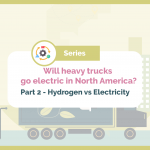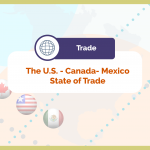Series – Will heavy trucks go electric in North America? – Part 3. Infrastructure
As we mentioned in our first post on the series Will heavy trucks go electric in North America?, One of the main concerns about electric heavy-duty trucks is the insufficient driving range for long-haul trucking. In this sense, a network of fast-charging stations along major transportation routes is going to be needed for the large-scale adoption of Electric Trucks.
The North American Council for Freight Efficiency and the Rocky Mountain Institute released a study on electric truck usage that states that for heavy-duty regional haul tractors, the technology is mature enough for fleets to be making investments in the production CBEVs. However, one of the biggest obstacles to adoption is the lack of charging infrastructure.
The infrastructure required to support electric trucks is vastly complex and expensive.
The same study states that in order to be able to charge Class 3, 4, and 5 vans and step vans, Class 6 box trucks, Class 8 terminal tractors, and Class 8 regional haul tractors, a total of 169 000 gigawatt hours of electricity are needed each year. But in return, more than 100 million metric tons of carbon would be avoided.
169 thousand gigawatt-hours is the equivalent of less than 5% of all U.S. annual electricity usage today.
Snapshot of the state of EV charging infrastructure in the United States and Canada
EV charging is a rapidly changing technology and growing infrastructure. As of December 2021, there were 50,054 public and private charging stations in the Station Locator database, which is a database that includes information on public and private nonresidential alternative fueling stations in the United States and Canada and currently tracks ethanol (E85), biodiesel, compressed natural gas, electric vehicle (EV) charging, hydrogen, liquefied natural gas, and propane stations.
Biden’s administration set a goal of building a network of 500,000 public EVSE ports in the United States by 2030. Will this goal be accomplished?
“ Station Locator has grown by an average of 5,077 EVSE ports per quarter since the beginning of 2020. In order to reach 500,000 EVSE ports by 2030, approximately 12,048 public EVSE port installations will be required each quarter for the next 9 years, indicating that the installation pace will need to increase significantly. As of Q4, the number of public EVSE port installations is 22.9% of the way towards the goal.” – National Renewable Energy Laboratory
However, medium- and heavy-duty EVs have different charging needs and require separate infrastructure investments from light-duty EVs.
In an EV Charging station, there are 3 Electric Vehicle Supply Equipment (EVSE) supply ports:
Level 1 (L1): 120 V; 1 hour of charging = 2–5 miles of range
Level 2 (L2): 240 V; 1 hour of charging = 10–20 miles of range
DC fast: 480+ V; 20 minutes of charging = 60–80 miles of range
When compared with Level 1 and Level 2 chargers, DC fast chargers are most the suitable option for heavy Trucks because have the highest power output and therefore provide the most charge in the least amount of time.
The number of DC fast EVSE ports remains a minority, yet is steadily increasing, as seen in the following figure provided by the National Renewable Energy Laboratory of the U.S.

Based on Atlas’ 2021 assessment that estimated the number of public and workplace chargers required in a scenario in which 100% of passenger vehicle sales are electric by 2035, the number of Level 2 and DC fast EVSE ports as of Q4 2021 is 8.1% and 30.2%, respectively, of the way toward meeting projected 2030 needs (McKenzie and Nigro 2021). This decreases to 3.5% and 27.8%, respectively, when Tesla EVSE ports are removed.
Of the networks with DC fast chargers, Tesla Supercharger has the largest share of public DC fast EVSE ports (58.0%), followed by Electrify America (14.4%) and EVgo (7.9%)
There are two types of EV Charging Stations
Non-networked EV charging stations
- Not connected to the internet
- Provide basic charging functionality without advanced communications capabilities.
- Non-networked charging is generally free or offered as an amenity for those who pay for parking or to access a business.
Networked EV charging stations
- Are connected to the internet via a cable or wireless technology
- Owners or site hosts manage who can access stations and control how much it costs drivers to charge their vehicle
How many hydrogen fueling stations are in the US
According to the U.S. Department of Energy, there are 53 Hydrogen fuelling stations in the United States and Canada. The exact locations can be found on the Alternative Fuels Data Center. However, heavy-duty vehicles, such as line-haul trucks, will require fueling stations with much higher capacities than existing light-duty stations.

Sources:
https://www.whitehouse.gov/briefing-room/statements-releases/2022/03/07/fact-sheet-vice-president-harris-announces-actions-to-accelerate-clean-transit-buses-school-buses-and-trucks/
https://www.energy.gov/articles/doe-projects-zero-emissions-medium-and-heavy-duty-electric-trucks-will-be-cheaper-diesel
https://www.volvogroup.com/en/news-and-media/news/2022/jan/news-4158927.html
https://www.greencarcongress.com/2022/05/20220519-ecascadia.html
https://www.volvogroup.com/en/news-and-media/news/2022/jan/news-4158927.html
https://freightliner.com/trucks/ecascadia/
https://nikolamotor.com/tre-bev
https://www.cnbc.com/2022/03/23/nikola-begins-production-of-battery-electric-tre-semitruck.html
https://www.transportdive.com/news/Trucking-battery-electric-versus-fuel-cell-hydrogen/610283/
https://afdc.energy.gov/files/u/publication/electric_vehicle_charging_infrastructure_trends_fourth_quarter_2021.pdf
https://ohioinsuranceagents.com/wp-content/uploads/2022/04/REVISED-UNDERSTANDING-TRUCKING-COVERAGES-003.pdf
usatoday.com









